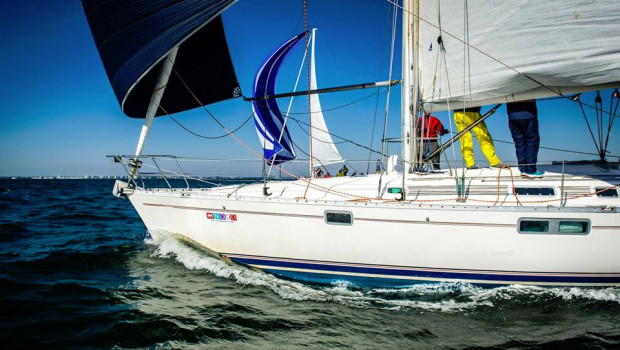Changing the Game to Grow the Sport
Published on April 25th, 2016
by Bill Wagner, Capital Gazette
Peter Henry was once a very active sailboat racer in the Annapolis (MD) area. The longtime Annapolis Yacht Club member campaigned a J/24 and Frers 33 named Mischief in the 1990s and earned his share of trophies.
When his children got older, Peter and wife Pam sold the racing sailboat and bought a cruising model. Their Grand Soleil 40, also named Mischief, was designed for comfort with all the basic amenities.
“I’ve got a 25-pound anchor and 75 feet of chain on one end and a stand-up shower on the other end,” Henry said.
Henry has not raced this Mischief in either Annapolis Yacht Club or Chesapeake Bay Yacht Racing Association events because he knew it would not be competitive in the usual classes that are offered.
However, Henry does miss the competition and camaraderie that comes with the racing scene. That’s why the Eastport resident was interested when AYC created classes that better suit his type of boat.
Annapolis Yacht Club recently announced the addition of Cruising Spinnaker, Cruising Non-Spinnaker, Short-handed Spinnaker and Short-handed Non-Spinnaker. Those four classes will now be offered starts for the AYC 80th Annual Regatta and again for the distance race held as part of the popular AYC Fall Series.
“I consider myself a retired racer. I don’t miss the uber competitive regattas, but I do miss racing to St. Michael’s and participating in certain other events,” Henry said. “So the idea of this cruising class is very appealing to me.”
Henry does not carry any downwind sails aboard his Grand Soleil 40, so he would certainly enter the non-spinnaker class. Mischief has roller furling headsails so it can easily be sailed by a relatively small crew.
“Going around government marks with a few friends would be a way to have fun without dealing with the craziness associated with serious sailboat racing,” he said. “I think there are a lot of cruisers who are curious about racing and would give it a try if the atmosphere wasn’t so overly intense.”
A fire that engulfed the Annapolis Yacht Club and ultimately caused more than $9 million worth of damage ushered in Debbie Gosselin’s term as commodore.
Rebuilding the clubhouse while figuring out a way for AYC to continue normal operations in a temporary building quickly became a major focus of her two-year tenure, but Gosselin was not about to allow issues related to the fire to distract from other goals. In particular, Gosselin took the helm with plans to increase participation in Annapolis Yacht Club’s on-water events.
“One of Commodore Gosselin’s major initiatives is to grow racing at AYC,” said Jonathan Bartlett, rear commodore for the club. “In order to do that, we need to be imaginative and think outside the box. There are a lot of members of that club that own nice boats and are not racing. Our challenge is to create ways to get them out on the water.”
To that end, Gosselin created a new Sailing Committee comprised of three of Annapolis Yacht Club’s most respected members: Dick Neville, Paul Parks and John White.
“I wanted a committee that could take a look at the big picture and coordinate all the various elements of our racing program, both on and off the water,” said Gosselin, owner of Annapolis-based Watermark Cruises. “This group of sailors we’re going after is difficult to identify and find. I think the club has to be more proactive in terms of marketing and sponsorship. Above all else, we need to make it fun and we need to make it easy in order to attract new racers.”
Annapolis Yacht Club officials are responding to an issue that has plagued sailboat racing for many years. Such renowned regattas as Key West Race Week have seen a dramatic drop off in entries. On the Chesapeake Bay, the Screwpile Lighthouse Challenge has shrunk.
Attrition has mostly occurred in the PHRF ranks that previously attracted the mom and pop-type programs. Regional inconsistencies have hampered PHRF, or Performance Handicap Racing Fleet, while other rating systems have failed to fill the void.
As a result, sailboat racing veered more toward the one-design arena where boats are equal. Some of the nation’s most popular events, such as Sailing World’s National Offshore One-Design Series, promote this type of racing with large fleets in such classes as J/70, J/22, C&C 30, Farr 30 and Etchells. As a result, owners of cruiser-racer sailboats have been left out in the cold.
Additionally, two-day regattas featuring multiple windward-leeward racing are not appealing to family programs that often struggle to find adequate crews because of the time commitment involved.
“With the way racing has gone, we have driven the newcomers and mildly interested sailors from the sport,” said White, owner of Whitehall Yacht Yard and a champion in a range of classes over the years. “It’s too complicated and too difficult, and therefore not inviting to the more casual sailor.”
AYC introduced Performance-Cruising and Classic/Corinthian classes for the 2015 Annapolis-to-Newport Race and succeeded in attracting 14 entries that otherwise would not have participated.
“Clearly these types of boats are out there and the owners are willing to race if given a good reason to do so,” Gosselin said. “We successfully added cruising classes to the Annapolis-to-Newport Race. We need to take that idea and apply it to all our race programs.”
Bartlett, a longtime salesman with North Sails-Chesapeake, sees three keys to appealing to cruising owners. “We need to keep things as simple as possible, as easy as possible and as fun as possible,” he said.
While newcomers are welcome to the racing scene, AYC officials also hope the addition of cruising and short-handed classes might bring back hardcore competitors who gave up the sport.
Dave Gendell grew up racing with his family on the Magothy River and Chesapeake Bay, eventually graduating to the grand prix circuit. Gendell, co-founder of SpinSheet Magazine, was part of many high-profile racing programs while single and newly married.
However, the arrival of children changed his priorities and Gendell found himself spending considerable time driving to and from swim practice or coaching lacrosse. Sailing is a lifelong activity for Gendell, who sought from the outset to introduce his son and two daughters to the sport.
So Gendell and good friend Dick Franyo bought an Alerion 28 for the primary purpose of day sailing with their kids. Juice is an older boat with Dacron sails and no spinnaker and thus not set up for hardcore racing. They do the Boatyard Bar & Grill Regatta each summer in order to support Chesapeake Region Accessible Boating, but otherwise do not race much.
However, the new classes being offered by AYC better fit the Alerion 28 and are attractive to Franyo and Gendell because they promote family participation.
“For us, it’s a family affair. We won’t go racing without two or three kids aboard,” Gendell said. “We love the races around government marks because it brings the compass into play and the kids like the feeling of sailing across the Bay on a set course as opposed to endless laps around drop marks. Our goal is to get them out there, pulling lines, understanding the course and steering for sections. It’s all about exposing them to racing, but not in an intense way.”
Annapolis Yacht Club’s membership features a slew of smart, veteran sailboat racers. Many have been around long enough to remember the hey day of the 1970s and 80s when sailboat racing was booming on the Chesapeake Bay.
AYC’s fledgling Sailing Committee took stock of why certain types of race offerings are fading while others are flourishing. Point-to-point events such as The Miles River Race (Annapolis-to-St. Michael’s), Race to Oxford and Governor’s Cup have remained popular for decades.
“You have to do what the market calls for and I think the common theme is that owners enjoy a course around government marks that is published well in advance,” White said. “If you offer that type of racing on a regular basis I think a large contingent of owners will be more apt to come out with family and friends or fewer people as crew.”
Parks, chairman of the Sailing Committee, said it is obvious the racer-cruiser type of boat is the largest untapped market for regattas. The West River resident believes relatively short distance races (12 or 15 nautical miles, depending on conditions) around government marks would also address the time factor preventing those owners from filling out an entry form.
“I think a one-day event is key for the cruiser. We discussed this issue at length among the committee and were in agreement that a known course going out and a good party afterward is a winning combination,” Parks said.
Sailing is supposed to be an enjoyable activity that promotes camaraderie, and those that go racing need to remember that aspect. While some sailors thrive on cutthroat competition and a quest for trophies, others would prefer a relaxing race followed by some fellowship at the yacht club.
“As a major club in the area, we need to do our part to restore an entry level position to the sport. We need to provide a venue that works for those folks,” White said. “There are so many sailboats around Annapolis. We’ve got to do something to get them out on the water.”
Source: Capital Gazette









 We’ll keep your information safe.
We’ll keep your information safe.